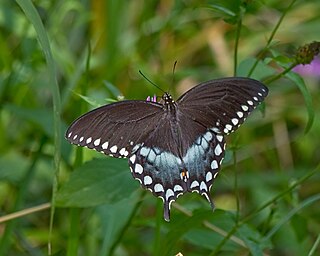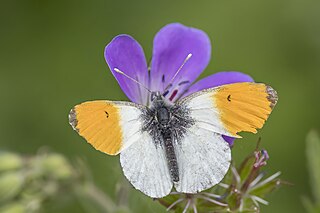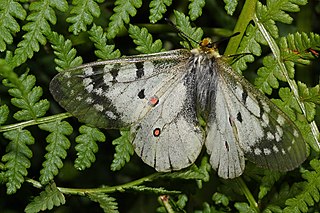
Aglais io, the European peacock, or the peacock butterfly, is a colourful butterfly, found in Europe and temperate Asia as far east as Japan. It was formerly classified as the only member of the genus Inachis. It should not be confused or classified with the "American peacocks" in the genus Anartia; while belonging to the same family as the European peacock, Nymphalidae, the American peacocks are not close relatives of the Eurasian species. The peacock butterfly is resident in much of its range, often wintering in buildings or trees. It therefore often appears quite early in spring. The peacock butterfly has figured in research in which the role of eyespots as an anti-predator mechanism has been investigated. The peacock is expanding its range and is not known to be threatened.

Papilio troilus, the spicebush swallowtail or green-clouded butterfly, is a common black swallowtail butterfly found in North America. It has two subspecies, Papilio troilus troilus and Papilio troilus ilioneus, the latter found mainly in the Florida peninsula. The spicebush swallowtail derives its name from its most common host plant, the spicebush, members of the genus Lindera.

Pieris rapae is a small- to medium-sized butterfly species of the whites-and-yellows family Pieridae. It is known in Europe as the small white, in North America as the cabbage white or cabbage butterfly, on several continents as the small cabbage white, and in New Zealand as the white butterfly. The butterfly is recognizable by its white color with small black dots on its wings, and it can be distinguished from P. brassicae by its larger size and the black band at the tip of its forewings.

Anthocharis cardamines, the orange tip, is a butterfly in the family Pieridae, which contains about 1,100 species. A. cardamines is mainly found throughout Europe and temperate Asia (Palearctic) The males feature wings with a signature orange pigmentation, which is the origin of A. cardamines' common name.

Gonepteryx rhamni, commonly named the common brimstone, is a butterfly of the family Pieridae. It lives throughout the Palearctic zone and is commonly found across Europe, Asia, and North Africa. Across much of its range, it is the only species of its genus, and is therefore simply known locally as the brimstone. Its wing span size is 60–74 mm (2.4–2.9 in). It should not be confused with the brimstone moth Opisthograptis luteolata.

Heliconius charithonia, the zebra longwing or zebra heliconian, is a species of butterfly belonging to the subfamily Heliconiinae of the family Nymphalidae. It was first described by Carl Linnaeus in his 1767 12th edition of Systema Naturae. The boldly striped black and white wing pattern is aposematic, warning off predators. It is the state butterfly of Florida.

Leptidea sinapis, or the wood white butterfly of the family Pieridae, is a small white butterfly that is mainly found in England, Ireland, and Northern Europe. The butterfly has white wings with grey or yellow markings near the center or tip of the wing. It flies slowly and low over its shrubbery habitat. Males initiate courtship with females and can mate multiply, while females tend to only mate once in their lifetime.

Anartia amathea, the brown peacock, is a species of nymphalid butterfly, found primarily in South America. This butterfly is very similar to the banded peacock or Anartia fatima, which primarily exists north of the range of Anartia amathea. The type locality is probably Suriname, and the species is found from Panama to Argentina; Grenada, Barbados and Antigua. It consumes nectar. It is reported as common in Argentina, Paraguay, Uruguay, the Brazilian highlands, the eastern Amazon, the Guianas, Venezuela, and Panama, as well as Trinidad and other Caribbean islands. North American records are either in error or refer to strays.

Manduca quinquemaculata, the five-spotted hawkmoth, is a brown and gray hawk moth of the family Sphingidae. The caterpillar, often referred to as the tomato hornworm, can be a major pest in gardens; they get their name from a dark projection on their posterior end and their use of tomatoes as host plants. Tomato hornworms are closely related to the tobacco hornworm Manduca sexta. This confusion arises because caterpillars of both species have similar morphologies and feed on the foliage of various plants from the family Solanaceae, so either species can be found on tobacco or tomato leaves. Because of this, the plant on which the caterpillar is found does not indicate its species. The caterpillar is highly toxic and can cause major swelling if touched.

The Sara longwing is a species of neotropical heliconiid butterfly found from Mexico to the Amazon Basin and southern Brazil. It is a colourful species: the dorsal wing surface is black with a large medial patch of metallic blue that is framed by two bands of white on the forewings. The ventral wing surface is a dull brown to black with muted bands and small red spots on the proximal margin; total wingspan is 55–60 mm.

Ornithoptera alexandrae, the Queen Alexandra's birdwing, is the largest species of butterfly in the world, with females reaching wingspans slightly in excess of 25 cm to 28 cm. This birdwing is restricted to the forests of the Oro Province in eastern Papua New Guinea.

The queen butterfly is a North and South American butterfly in the family Nymphalidae with a wingspan of 80–85 mm. It is orange or brown with black wing borders and small white forewing spots on its dorsal wing surface, and reddish ventral wing surface fairly similar to the dorsal surface. The ventral hindwings have black veins and small white spots in a black border. The male has a black androconial scent patch on its dorsal hindwings. It can be found in meadows, fields, marshes, deserts, and at the edges of forests.

Battus philenor, the pipevine swallowtail or blue swallowtail, is a swallowtail butterfly found in North America and Central America. This butterfly is black with iridescent-blue hindwings. They are found in many different habitats, but are most commonly found in forests. Caterpillars are often black or red, and feed on compatible plants of the genus Aristolochia. They are known for sequestering acids from the plants they feed on in order to defend themselves from predators by being poisonous when consumed. The adults feed on the nectar of a variety of flowers. Some species of Aristolochia are toxic to the larvae, typically tropical varieties. While enthusiasts have led citizen efforts to conserve pipevine swallowtails in their neighborhoods on the West coast, the butterfly has not been the subject of a formal program in conservation or protected in legislation. The butterfly is however of "Special Concern" in Michigan, which is on the Northern limit of its range.

Eumaeus atala, also known as the Atala butterfly or coontie hairstreak, is a small colorful butterfly in the family Lycaenidae. It is found in southeastern Florida in the United States, Cuba, the Bahamas, and the Cayman Islands in the West Indies. Its coloration and habits are unique among butterflies within its range.

The giant swallowtail is the largest butterfly in North America. It is abundant through many parts of eastern North America; populations from western North America and down into Panama are now considered to belong to a different species, Papilio rumiko. Though it is often valued in gardens for its striking appearance, its larval stage can be a serious pest to citrus farms, which has earned its caterpillars the names orange dog or orange puppy. The giant swallowtail caterpillars possess remarkable camouflage from predators by closely resembling bird droppings. They use this, along with their osmeteria, to defend against predators such as wasps, flies, and vertebrates.

The variable checkerspot or Chalcedon checkerspot is a butterfly in the family Nymphalidae. It is found in western North America, where its range stretches from Alaska in the north to Baja California in the south and extends east through the Rocky Mountains into Colorado, Montana, New Mexico and Wyoming. The butterfly is usually brown or black with extensive white and yellow checkering and some red coloration on the dorsal wing. Adult wingspan is 3.2–5.7 cm (1.3–2.2 in). Adult butterflies feed on nectar from flowers while larvae feed on a variety of plants including snowberry (Symphoricarpos), paintbrush (Castilleja), Buddleja, Diplacus aurantiacus and Scrophularia californica.

Epargyreus clarus, the silver-spotted skipper, is a butterfly of the family Hesperiidae. It is claimed to be the most recognized skipper in North America. E. clarus occurs in fields, gardens, and at forest edges and ranges from southern Canada throughout most of the United States to northern Mexico, but is absent in the Great Basin and western Texas.

Jalmenus evagoras, the imperial hairstreak, imperial blue, or common imperial blue, is a small, metallic blue butterfly of the family Lycaenidae. It is commonly found in eastern coastal regions of Australia. This species is notable for its unique mutualism with ants of the genus Iridomyrmex. The ants provide protection for juveniles and cues for adult mating behavior. They are compensated with food secreted from J. evagoras larvae. The ants greatly enhance the survival and reproductive success of the butterflies. J. evagoras lives and feeds on Acacia plants, so butterfly populations are localized to areas with preferred species of both host plants and ants.

Parnassius smintheus, the Rocky Mountain parnassian or Rocky Mountain apollo, is a high-altitude butterfly found in the Rocky Mountains throughout the United States and Canada. It is a member of the snow Apollo genus (Parnassius) of the swallowtail family (Papilionidae). The butterfly ranges in color from white to pale yellow-brown, with red and black markings that indicate to predators it is unpalatable.

Lycaena rubidus, the ruddy copper, is a butterfly of the family Lycaenidae. It is found in the western mountains of North America. Adults lay their eggs on plants of the genus Rumex, which later become the larval food plants. This butterfly gets its name from the brightly colored wings of the males, which are important in sexual selection. Its larvae exhibit mutualism with red ants, and are often raised in ant nests until they reach adulthood. Adults are on wing from mid-July to early August.




















